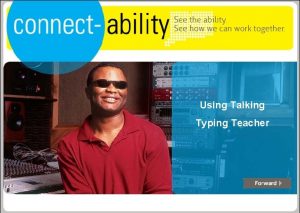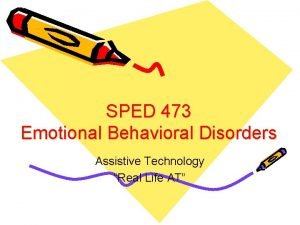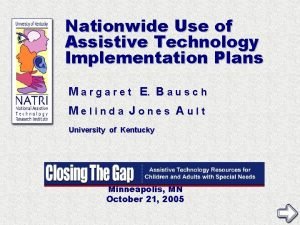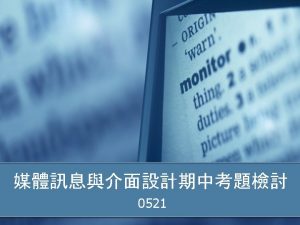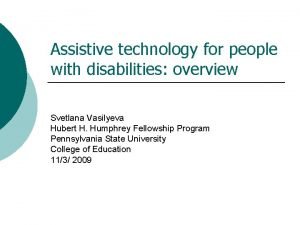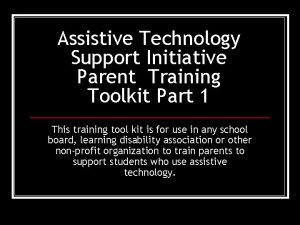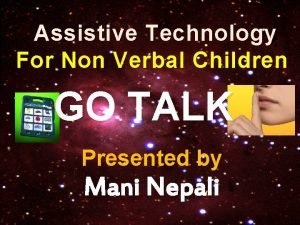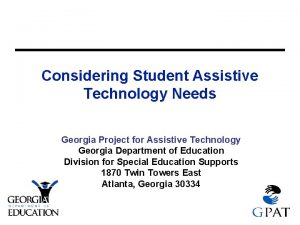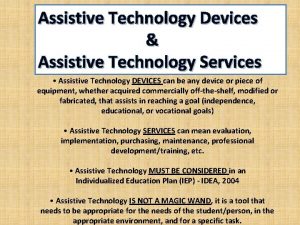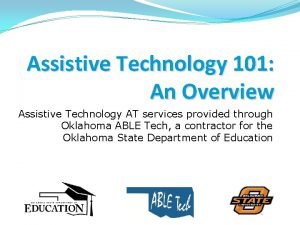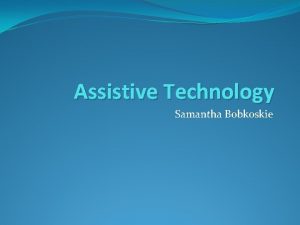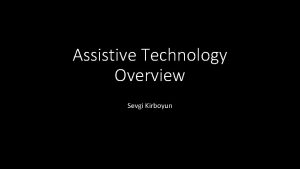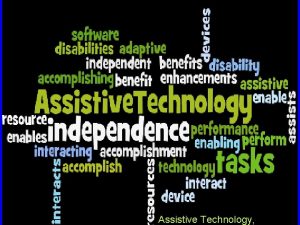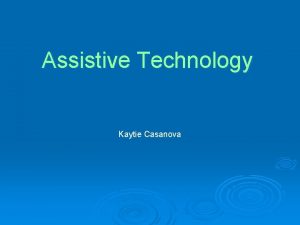Chapter 36 Assistive Technology Overview Assistive technology AT










- Slides: 10

Chapter 36 Assistive Technology Overview • Assistive technology (AT) and assistive medical technology • Types and examples of rehabilitative and medical AT • Types of conditions with need for AT • Assessment, acquisition, training; universal design • Funding; durable medical equipment (DME), limitations on purchase Chapter 36 slides in Children with Disabilities, Seventh Edition, Online Companion Materials. Copyright © 2013 Paul H. Brookes Publishing Co. , Inc. All rights reserved.

https: //www. youtube. com/watch? v=Y 5 CEeqt 4 kv. I https: //www. youtube. com/watch? v=Ic. U Nnnw. Fm 4 g Chapter 36 materials in Children with Disabilities, Seventh Edition, Online Course Materials. Copyright © 2013 Paul H. Brookes Publishing Co. , Inc. All rights reserved.

Definitions and Overview Assistive technology Medical assistive technology 1. Assistive devices: alleviate impact 2. Adaptive/alternative technology: substitutes/makes up for loss of function 3. Augmentative devices: increase area of functioning Three Types: 1. Low tech 2. Mid tech 3. High tech Chapter 36 slides in Children with Disabilities, Seventh Edition, Online Companion Materials. Copyright © 2013 Paul H. Brookes Publishing Co. , Inc. All rights reserved.

Technology for Medical Assistance • Replace or augment a vital body function; examples: • Respiratory technology assistance • Monitoring/surveillance • Nutritive assistive • Intravenous (IV) therapy • Augment/protect kidney function • Respiratory support for 1. Lung or heart problems 2. Problems with neurological control of breathing and/or weakness of the muscles • Examples: supplemental oxygen, continuous positive airway pressure, chest physiotherapy, nasal cannulae, positive end expiratory pressure Chapter 36 slides in Children with Disabilities, Seventh Edition, Online Companion Materials. Copyright © 2013 Paul H. Brookes Publishing Co. , Inc. All rights reserved.

Technology for Medical Assistance (continued) • Monitoring/surveillance devices • Pulse oximeters • Cardiorespiratory monitors • Nutritional (gastrointestinal) fluid assistance • Nasogastric tube • Nasojejeunal tube • Gastrostomy tube (G tube), jejunostomy tube (J tube), G-J tube • IV fluid assistive devices • Catheter (central line), peripherally inserted central catheter, subcutaneous infusion port Chapter 36 slides in Children with Disabilities, Seventh Edition, Online Companion Materials. Copyright © 2013 Paul H. Brookes Publishing Co. , Inc. All rights reserved.

Assistive Technology for Disabilities: Principles and Examples • Universal design • Design for all people (e. g. , wheelchair ramps) • Technology for physical disabilities • Low-tech: ankle-foot orthoses, hand splints, spinal braces • Mid-tech: functional electrical stimulators, treadmills with support frames, dynamic braces • High-tech: personal computers • Technology for sensory impairments • Low-tech: magnification devices • Mid-tech: alerting systems, laser canes, taped books • High-tech: personal computers, cochlear implants Chapter 36 slides in Children with Disabilities, Seventh Edition, Online Companion Materials. Copyright © 2013 Paul H. Brookes Publishing Co. , Inc. All rights reserved.

Assistive Technology for Disabilities: Principles and Examples (continued) • Technology for communication impairments (augmentative and alternative communication [AAC]) • Low-tech: picture cards • Mid-tech: scanning communication device • High-tech: i. Pad • Technology for cognitive, attentional, and learning disabilities • Computer-based instruction • Individualized • Software programs • Distance learning Chapter 36 slides in Children with Disabilities, Seventh Edition, Online Companion Materials. Copyright © 2013 Paul H. Brookes Publishing Co. , Inc. All rights reserved.

Assessment for Assistive Technology Interdisciplinary team: • Specialists, child, family, social worker, others • Begin with low tech • Functional evaluation of the individual • ICF (WHO, 2001), Wee-FIM (Wong et al. , 2005) • Ensure good match/usefulness: MPT (Scherer, 1998 a; Scherer & Craddock, 2002), QUEST 2. 0 (Demers, Weiss. Lambrou & Ska, 2002), PIADS (Day, Jutai, & Campbell, 2002; Jutai et al. , 2005) • Training in the use of the device • Pre-use training: demos, simulators • Monitoring See the textbook Children with Disabilities, Seventh Edition, for full citation and reference information. Chapter 36 slides in Children with Disabilities, Seventh Edition, Online Companion Materials. Copyright © 2013 Paul H. Brookes Publishing Co. , Inc. All rights reserved.

Effects of Assistive Technology on Family and Community • Increases self-worth, improves functioning • Social isolation risk • Prolonged use (> 2 years) of some significant AT devices can lead to family stress/depression • Home care option depends on multiple factors • Arrange therapy before discharge • Develop individualized family service plan or individualized education program Chapter 36 slides in Children with Disabilities, Seventh Edition, Online Companion Materials. Copyright © 2013 Paul H. Brookes Publishing Co. , Inc. All rights reserved.

Effects of Assistive Technology on Family and Community (continued) • Funding Issues 1. Payment for home nursing care 2. DME and supplies • • • Primary funding: insurance; “approved DME listing” School: Individuals with Disabilities Education Improvement Act (IDEA) of 2004 (PL 108 -446), Technology-Related Assistance for Individuals with Disabilities Act (Tech Act) of 1988 (PL 100 -407) Coordinate payment for AAC devices • Advocacy information • Tech Act sites, Able. Data, Council for Exceptional Children Chapter 36 slides in Children with Disabilities, Seventh Edition, Online Companion Materials. Copyright © 2013 Paul H. Brookes Publishing Co. , Inc. All rights reserved.
 Talking typing
Talking typing Assistive technology for emotional disturbance
Assistive technology for emotional disturbance Assistive technology implementation plan
Assistive technology implementation plan Assistive technology wikipedia
Assistive technology wikipedia Meaning of assistive technology
Meaning of assistive technology Audioize
Audioize Illinois assistive technology program
Illinois assistive technology program Don johnson assistive technology
Don johnson assistive technology Go talk assistive technology
Go talk assistive technology Georgia project for assistive technology
Georgia project for assistive technology Assistive technology toys
Assistive technology toys
